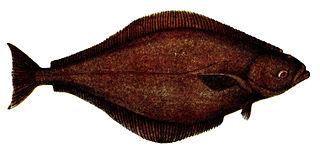
The Chiasmodontidae, snaketooth fishes or swallowers, are a family of deep-sea predatory ray-finned fishes, part of the order Scombriformes, that are found in all oceans.

Tetrapturus is a genus of marlins commonly called spearfish, found in tropical and subtropical oceans throughout the world. Some are popular sport fish in big-game fishing.

Hippoglossus is a genus of very large righteye flounders. It comprises two species of halibut, with one species native to the northern Atlantic Ocean and the other species native to the northern Pacific Ocean.
The Papuan seerfish also called the Papuan Spanish mackerel, is a species of fish in the family Scombridae. It is endemic to the Gulf of Papua off the mouth of the Fly River. It is the smallest species in the genus Scomberomorus. Sexual maturity is attained at much less than 30 cm fork length.

Pleuronichthys is a genus of fish in the family Pleuronectidae found in the Pacific Ocean.

Grammatorcynus is a genus of ray-finned bony fish in the family Scombridae. This genus together with Acanthocybium and Scomberomorus are comprised by the tribe Scomberomorini, commonly known as the Spanish mackerels or seerfishes.

The leaping bonito is a species of saltwater finfish from the Scombridae (Mackerel) family. Scombridae includes such tribes as the mackerels, tunas, and bonitos – of the latter of which, the Sardini tribe, this fish is a member. It is the only member of the genus Cybiosarda, which is therefore called a monotypic taxon. Since the bonitos and tunas are close relatives, this fish has variously been referred to by such other common names as Australian tuna, striped bonito, and Watson's bonito.

Rastrelliger is a mackerel genus in the family Scombridae. The three species of Rastrelliger together with the four species of Scomber comprise the tribe Scombrini, known as the "true mackerels".

Peprilus is a genus of ray-finned fish in the family Stromateidae found in Pacific and Atlantic Oceans.

The blacksail snake mackerel, known also as the black snoek, is a species of snake mackerel found in the Indo-Pacific from shallow water to a depth of at least 400 m (1,300 ft) where they appear to prefer slopes on seamounts and ridges. They are known for making diel vertical migrations to near-surface waters at night, feeding on fish, squid and crustaceans. This species reaches a total length of 2 m (6.6 ft) though most are around 1 m (3.3 ft). This species is of minor importance to local commercial fisheries. It is at the only member of the genus Thyrsitoides, making the genus monotypic.

Achirus is a genus of American soles native to tropical and subtropical parts of the Americas. They are mainly found in coastal areas, including salt and brackish water, but some species are found in fresh water.

Apionichthys is a genus of mostly freshwater American soles native to South America.

Taractichthys is a genus of marine ray-finned fishes from the family Bramidae, the pomfrets.
Neocaristius heemstrai is a species of fish in the family Caristiidae, the manefishes. It is native to the oceans of the southern hemisphere where it is known to occur at depths of from 420 to 1,360 metres. This species grows to a length of 11.8 centimetres (4.6 in) SL.

Chiasmodon is a genus of snaketooth fishes.

Kali is a genus of snaketooth fishes, deep ocean fish from the family Chiasmodontidae.

Pseudoscopelus is a genus of snaketooth fishes.

Lepidopus is a genus of cutlassfishes.

Scombriformes, also known as Pelagia and Pelagiaria, is an order of ray-finned fish within the clade Percomorpha. It contains 287 extant species in 16 families, most of which were previously classified under the suborders Scombroidei and Stromateoidei of the order Perciformes.

Dysalotus alcocki is a species of deep sea fish, a swallower, from the family Chiasmodontidae which is found in the tropical and temperate oceans around the world. The adults fed mainly on fish. The juveniles and larvae are most frequently recorded from shallower waters while adults are mostly caught from depths of over 1,000 metres (3,300 ft). The generic name is derived from the Greek dysalotos which means "difficult to catch" and the specific name honours the English zoologist Alfred William Alcock (1859-1933).

















